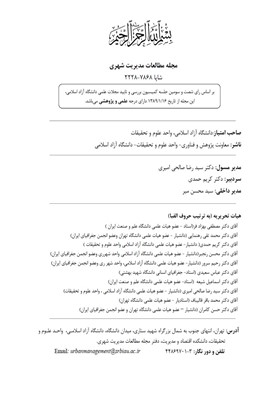شناسایی و بررسی پتانسیلها و قابلیتهای موجود زمین با تأکید بر توسعه میانافزا (مطالعه موردی: محلات شهر سردشت)
محورهای موضوعی : مطالعات مدیریت شهریکرامت الله زیاری 1 , احمد پوراحمد 2 , رزگار حمزه پور 3 *
1 - استاد
2 - استاد
3 - دانشجو
کلید واژه:
چکیده مقاله :
مقدمه و هدف پژوهش: در پی رشد شتابان جمعیت و ظهور تحولات جدید شهرنشینی در جهان، شاهد گسترش الگوهای توسعه ی شهری همانند گسترش افقی و پراکنده رویی هستیم که سبب شکل گیری حومهها، تخریب اراضی کشاورزی و به فراموشی سپرده شدن بافتها میانی و تهی شدن آنها از درون شده است. این امر لزوم به کارگیری ظرفیتها و پتانسیلهای درونی و میانی شهر را ضروری مینماید. از این رو هدف این پژوهش، شناسایی و بررسی ظرفیتها و پتانسیلهای توسعه میان افزا در محلات شهر سردشت میباشد. روش پژوهش: نوع تحقیق کاربردی و روش بررسی آن توصیفی تحلیلی است. در این پژوهش با استفاده از روش تحلیل سلسله مراتبی (AHP) و نرم افزار choice expert به اولویت بندی و وزن دهی معیارها پرداخته شد و از سامانه اطلاعات جغرافیایی (GIS) برای تولید و پردازش لایهها استفاده شد. یافتهها: در این پژوهش با 8 معیار و شاخص تأثیرگذار شامل تراکم جمعیتی، اراضی بایر و متروکه، اراضی قهوهای، کیفیت ساختمان، طبقات ساختمان، عمر ساختمان، کاربری نظامی و گورستان، سطوح میان افزا شناسایی و مورد استفاده قرار گرفت. در پایان با جمع معیارها و زیر معیارها (لایه های) وزن دار به وسیله عملیات ریاضی مبادرت به تولید نقشه نهایی توسعه محلات سردشت و اولویتبندی آنها شد. نتیجه گیری: نقشه نهایی بیانگر آن است که محلات 3 و 8 با قرار گرفتن در اولویتهای 1 و 2 دارای بیشترین پتانسیل توسعه میان افزا و محلات 5 و 9 در اولویتهای آخری دارای کمترین ظرفیت جهت توسعه از درون (میان افزا) میباشند.
Following the rapid population growth and emergence new urbanization changes in the world, we have been witnessed the extension of urban development patterns such as horizontal expansion which has caused to form suburbs, to destroy agricultural lands and to forget intermediate textures and their depletion from inside. These matters makes it necessary using capacities and potentials of the inside of the town. Therefore the purpose of this paper is identify and examine capacities and potentials of infilling development in the neighborhoods of Sardasht. The kind of research is practical and its review method is descriptive-analytical. Analytic Hierarchy Process (AHP) and expert choice software were used to prioritize and validating standards and Geographic Information System (GIS) was used for layers production and processing. During this process 8 standards and effective indexes including population density, deserted and abandoned lands, brown lands, building quality, building floors, building age, military and cemetery applications were identified and applied. Finally by summing together of mass standards and sub standards, using mathematical operations attempted to create the final development map and their prioritizing. The final map indicates that the 3 and 8 neighborhoods which are placed in 1 and 2 priorities have the most infill development potential and 5 and 9 neighborhoods in the end of the priorities have the lowest capacity to develop from the inside(infill development).

